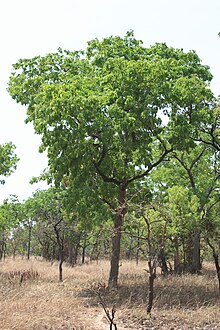Isoberlinia doka is a hardwood tree native to African tropical savannas and Guinean forest-savanna mosaic dry forests where it can form single species stands.[2] The tree is exploited for its economic value as a commercial timber. The leaves and shoots of the tree dominate the diet of the Giant Eland in its range.[3] The tree is a host plant for Anaphe moloneyi (superfamily Thaumetopoeidae), one of the caterpillars that produces a wild silk, sayan, local to parts of Nigeria.[4]
| Isoberlinia doka | |
|---|---|

| |
| Dry forest of Isoberlinia doka in Comoé-Léraba Reserve, Burkina Faso | |
| Scientific classification | |
| Kingdom: | Plantae |
| Clade: | Tracheophytes |
| Clade: | Angiosperms |
| Clade: | Eudicots |
| Clade: | Rosids |
| Order: | Fabales |
| Family: | Fabaceae |
| Genus: | Isoberlinia |
| Species: | I. doka
|
| Binomial name | |
| Isoberlinia doka | |
References edit
- ^ Contu, S. (2012). "Isoberlinia doka". IUCN Red List of Threatened Species. 2012: e.T19892774A20090324. doi:10.2305/IUCN.UK.2012.RLTS.T19892774A20090324.en. Retrieved 12 November 2021.
- ^ Baker, Kathleen M. (2000). Indigenous Land Management in West Africa: An Environmental Balancing Act (Oxford Geographical and Environmental Studies). Oxford University Press. ISBN 0-19-823393-0.
- ^ Kingdon, Jonathan (1984). East African Mammals: An Atlas of Evolution in Africa. University of Chicago Press. ISBN 0-226-43718-3.
- ^ Kriger, Colleen E. (2006). Cloth in West African History. AltaMira Press. ISBN 0-7591-0422-0.
External links edit
